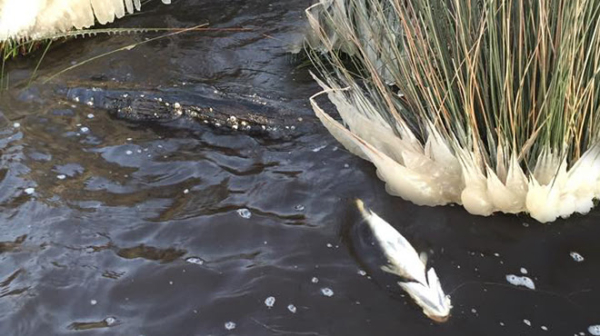 Throughout the winter, the Division of Marine Fisheries remains alert for any sign of cold stun events. Cold stun events occur when the environment becomes so cold that aquatic wildlife in the area are physically affected and become lethargic or appear stunned. A cold stun can be triggered by either 1) a strong cold front and/or melting snow and ice causing a sudden drop in water temperature or 2) a long period of cold air temperatures slowly decreasing water temperatures to a level that aquatic wildlife cannot survive. The effects of cold stun events can be localized to a small area, like a single river tributary, or widespread, affecting multiple river systems or the entire coast.
Throughout the winter, the Division of Marine Fisheries remains alert for any sign of cold stun events. Cold stun events occur when the environment becomes so cold that aquatic wildlife in the area are physically affected and become lethargic or appear stunned. A cold stun can be triggered by either 1) a strong cold front and/or melting snow and ice causing a sudden drop in water temperature or 2) a long period of cold air temperatures slowly decreasing water temperatures to a level that aquatic wildlife cannot survive. The effects of cold stun events can be localized to a small area, like a single river tributary, or widespread, affecting multiple river systems or the entire coast.
Cold stun events involving spotted seatrout have been documented for at least three centuries in North Carolina. In the past 10 years, spotted seatrout cold stun events were observed in 2009, 2010, 2015, and 2018. Spotted seatrout are particularly vulnerable to cold water temperatures due to a combination of their biology and behavior. Spotted seatrout are a warm water species, abundant throughout the U.S. South Atlantic and the Gulf of Mexico and are uncommon north of Chesapeake Bay. As winter approaches, spotted seatrout move into deeper, warmer water in the estuaries and ocean. Those that remain in estuaries are more likely to experience rapid water temperature declines associated with cold stuns due to their relatively shallow depth.
Like all species, spotted seatrout select habitats within a water temperature range optimal for survival. If water temperatures fall below 45 degrees Fahrenheit , spotted seatrout will begin to experience stress and try to move to warmer water. If spotted seatrout are trapped for an extended period in water below 41 F or the water temperature changes too quickly for the fish to escape, then the fish may become stunned. Most fish seen stunned do not survive. Spotted seatrout have an absolute minimum water temperature of around 37 F, below which there is very little chance of survival.
The 2012 N.C. Spotted Seatrout Fishery Management Plan recognized the impact of mortality due to cold water temperatures on the spotted seatrout population and wanted to ensure that surviving spotted seatrout had the opportunity to spawn in the spring, potentially increasing the number of juvenile fish entering the fishery the following year. As a result, the plan implemented an adaptive management strategy which closed spotted seatrout harvest through June 15 in the event of significant cold stuns. In December 2016, the division adopted improved adaptive management guidelines for spotted seatrout cold stun closures that divided the state into cold stun management areas and established water temperature triggers of 41 F for eight consecutive days or 37 F for a consecutive 24-hour period. If either of these conditions are met in at least two cold stun management areas, then the director will use proclamation authority to close spotted seatrout harvest until June 15. The division monitors water temperatures year around in cold stun prone areas using continuous water temperature logging devices, and data from these devices are used to inform management decisions.
The guidelines were used to evaluate cold stun events in the winters of 2017 and 2018. A harvest closure for spotted seatrout was implemented from Jan. 5, 2018 until June 15, 2018 because water temperature triggers were met in two of the spotted seatrout management areas. These adaptive management guidelines will continue to be used to evaluate future spotted seatrout cold stun events and make decisions about possible closures.
For more information about how North Carolina manages spotted seatrout cold stun events, contact division biologist Tracy Bauer.


 Advertising
Advertising